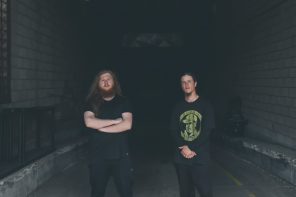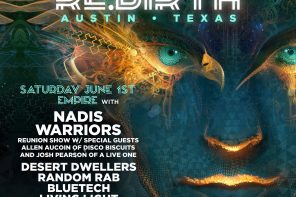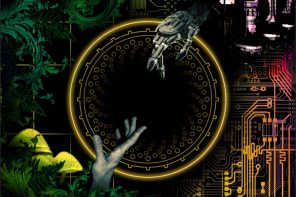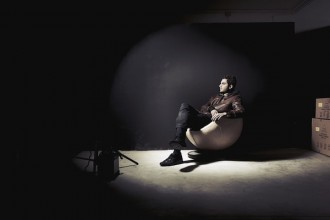(Originally published at H+ Magazine…visit for comments!)
– It’s 2006, and I am now accustomed to the jumbo screens to either side of the main stage at any given major music festival. I still remember having no choice but to elbow my way to the front if I wanted a better view, and it’s still a fresh feeling: gratitude for being able to leave my binoculars at home and enjoy the view from the lawn.
– It’s 2007, and I am a consultant for social music network iggli.com, a start-up hoping to build online communities around a “celestial jukebox” (i.e., software that will stream any music to any internet-enabled device, effectively and immediately rendering music ownership battles obsolete). Another of their fun toys is a streaming matrix of concert photography fed live from member’s cell phones while they are at the shows…search by artist, location, or date, and everyone’s angles ticker-tapes past as fast as they can be uploaded.
– It’s 2008, and I meet the representatives of Gen Audio, an audio firm promoting their game-changing new sound mixing technology. Their software AstoundSound allows engineers to place moving sound sources anywhere in an infinite virtual sphere, generating spatiotemporal natural sonic environments with the wizardry of phasing and psychoacoustics. Two of their earliest applications are in as-if-you’re-there telepresencing and AR overlays so commercial pilots can hear aviation information superimposed over real-world topography, as if audio beacons are actually planted across the landscape. Not far behind are “audio planetariums” that offer audiences an auditory journey through the cosmos…and ultimately, perhaps even rich enough 4D audio AR that the blind will be able to drive.
– It’s 2009, and I am watching the Bonnaroo Music Festival in Tennessee…from my friend’s couch in Kansas City. Every concert at this event – one of the largest music festivals in the world – is streaming live from a team of professional videographers, courtesy of excellent info-age PR. Bonnaroo isn’t the only one, either; website iClips.net travels from festival to festival all summer providing free multi-camera streams of most of the summer’s most exciting musical events. Meanwhile, technology’s weird consequences for location-based entertainment grow more profound as “silent raves” (at which everyone wears headphones, which may or may not even be playing the same music) grow in popularity.
Let’s telescope this to about five years from now. The celestial jukebox, now realized through search engines specialized for streaming music, has dealt a fatal blow to conventional music sales. Like most other entertainment media, music is now in the business of creating social experiences, rather than leasing licenses on intellectual property. Music sales continue in the form of interactive multimedia album packages, but most of the action takes place at concerts. And concerts don’t look like they used to.
When I get to the theater I am half an hour late, but that’s okay because my friends and I took a taxi and have been watching and listening through our glasses on the ride down. Our tickets – purchased and redeemed online – grant us access not only to the building, but also a secure server where other concertgoers are streaming live feeds from their own glasses. The user agreement we sign grants the venue limited access to our glasses’ positional and biometric data – which enables us to map, among other things, where exactly in the house each anonymized video feed is located. When we get there the place is packed, but a quick search through the venue’s map of live feeds directs us through a relatively open swath of crowd and to a corner offering decent line-of-sight. I still can’t see the lead guitarist’s hands from where I’m standing, so I keep a picture-in-picture of one of the less-bouncy feeds from up front.
Some things remain the same: live music is still mostly about paying for bandwidth and commodifying the je ne sais quoi of physical bodies in actual space. My friends at home watch the show on a lo-fi, high-latency feed with sound in mere stereo (“AstoundSound where available”) and from the theater’s in-house team – now standard in many upscale venues as a free appetizer. Advertisements augment empty stage space that for us ticket holders is painted in vivid, evolving, live visuals that combine band themes with optional user-specific variation based on our glasses’ biometrics feed.
Tonight, my head’s not in the right place, my own biofeed-constrained graphics are boring me. I check out the band-provided “pop-up video” and “cymatic transcript” overlays, then spend a few minutes stumbling through the anonymous AR-scapes of other audience members before voting for a few I like and breeding them with my own bookmarked algorithms. A few minutes of calibration is worth the more interesting view. The same biofeeds are in input channel for stage musicians, who have brought the philosophy of Web 2.0 to a new level by mapping pulse, skin galvanic response, and other values to musical outputs – allowing 21st Century bands and DJs a level of intimate co-improvisation that, to varying degrees, has eroded the artist-audience boundary.
If I had settled for a telepresence ticket, I’d be watching this stream to my home theater in fully immersive audio and hi-res video, but my access would be limited to user feeds behind a virtual velvet rope. If I had sprung for VIP access, I would have reserved seating with bottle service, feeds from behind the band and backstage, and limited invites to medium-quality feeds for a few friends who couldn’t make it.
(Authentication keys exchanged between ticket-holding hardware and the venue make it nearly impossible to broadcast paid feeds – it took me a while to get used to sitting at home with friends spaced out on the couch nearby, catching comped invites to a different show. Not too different from the self-conscious “laptop parties” of yesteryear.)
Telepresencing technology and the raw hunger of fans for free and novel entertainment is in an arms race with corporate ingenuity’s efforts to commodify increasingly abstract souvenir experiences. The two market forces combine to generate more options: in response to freely available live music, the industry must work harder to create points of artificial scarcity and more intimate/intricate pay-to-play options.
And so, at the same time that enhanced albums have totally outsold music without user-remix options and liner notes that rabbit-hole into elaborate online games, live music is exploring baroque new dimensions of interactivity. The positive feedback between bandwidth and creative control creates a new hierarchy of consumer engagement, a hundred new strata of participant-observers. Compared to even a few years ago, every seat – even at home – is the best seat in the house.
And that’s without even touching on theater.
(For more on the intersections of creativity and technology, visit MichaelGarfield.blogspot.com)






